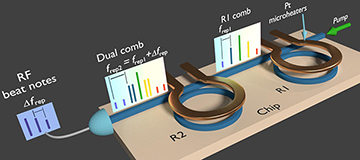The single-chip, single-laser, dual-frequency-comb source devised by the Columbia engineers involves a pair of microring resonators, with overlying platinum microheaters to allow individual tuning of the resonance wavelength. [Image: A. Dutt, A. Mohanty, E. Shim, G. Patwardhan/Columbia Engineering] [Enlarge image]
In the past decade, the technique of dual-comb spectroscopy (DCS) has opened up new possibilities for rapid, high-spectral-resolution molecular analysis. A team at Columbia University, USA, led by OSA Fellows Michal Lipson and Alexander Gaeta, has now taken a big step toward bringing the power of DCS to the chip scale, demonstrating a dual-comb setup run by a single laser on a single, millimeter-scale, silicon-based chip (Sci. Adv., doi: 10.1126/sciadv.1701858).
The researchers believe that the radical miniaturization and CMOS-compatibility of their dual-comb setup could extend the technique into a variety of portable, field-ready DCS devices. “There is now a path,” Gaeta said in a press release, “for trying to integrate the entire device into a phone or a wearable device.”
The dual-comb speed advantage
DCS is a souped-up version of frequency comb spectroscopy, the pioneers of which captured the 2005 Nobel Prize in Physics. In the basic technique, the millions of equally spaced “teeth” of an optical frequency comb act as an array of optical tuning forks, each sensitive to the resonance frequency of different molecular-bond vibrations. The differential absorption of the frequency comb components when passed through a sample thus allows broadband spectroscopic identification of complex molecules at a high spectral resolution.
DCS speeds up frequency comb spectroscopy by mixing two combs with slightly different repetition rates (see “Dual-Comb Spectroscopy,” OPN, January 2017). The mixture allows the THz-frequency optical signal to be read via heterodyne detection—that is, through analyzing the radio-frequency “beat” between the two combs using standard RF digital-signal-processing techniques. As a result, a good DCS signal can be obtained in tens of microseconds, versus the seconds to tenths of seconds required for non-DCS techniques.
Getting DCS on a chip
There’s been considerable progress lately in shrinking individual frequency combs down to the chip scale. But single-chip DCS has proved more elusive. Many DCS setups have relied on mode-locked, macroscopic Ti:sapphire or fiber lasers, with phase stabilization feedback loops, to produce the slightly offset combs and keep them mutually coherent. The frequency combs that have been shrunk to chip scale commonly use a different technique, involving Kerr nonlinearities in high-quality-factor microresonators. And it’s been tough to mode-lock and tune the relative resonance frequencies of two such microresonator-based combs in a single-chip setup.
To get past that dilemma, the team led by Lipson and Gaeta began with a standard silicon wafer, and used low-pressure chemical vapor deposition to lay down a 730-nm-thick layer of silicon nitride—a material that’s “widely used in the silicon-based semiconductor industry,” according to Lipson. The team then employed electron-beam lithography to pattern two microring resonators with slightly different radii (50.04 and 49.98 μm, respectively), coupled to a single bus waveguide. The two different radii allow the creation of two frequency combs with the slightly different repetition rates that DCS requires.
Finally, the researchers sputter-deposited a 100-nm-thick platinum loop atop each of the two microring resonators. The platinum rings act as individually controllable microheaters that allow the team to tweak the resonance wavelengths in the microring resonators via the thermo-optic effect (that is, temperature-driven changes the material’s refractive index). This allows the combs to be rapidly and repeatedly tuned in tandem into resonance with a single pump laser—in this case, a 1561-nm continuous-wave source tied into the bus waveguide.
Rapid result
The Columbia team found that its microresonator comb setup could produce broadband optical spectra spanning a 51-THz frequency range, which, via the DCS technique, could be downsampled into an RF-readable beat signal. The researchers tested out the device by performing time-domain absorption spectroscopy of the organic solvent dichloromethane, across a broad 170-nm wavelength range, and found that they could acquire good spectra in a rapid, 20-μs acquisition time using their on-chip dual-comb source. That compares, according to the researchers, with a several-second acquisition time for this molecular species using conventional spectrometers.
The next steps for the team will be to work on increasing the bandwidth of the dual combs through dispersion engineering, and on approaches to boost the spectral resolution of the on-chip source. At present, the comb teeth on the on-chip DCS platform are relatively widely spaced, making it suitable mainly for spectroscopic identification of liquids and solids. Extending the functionality to gas detection will require finer-spaced comb teeth, which the researchers believe can be achieved through more refined tuning of the laser and resonator or by tweaking the resonator geometry.
As these improvements come to pass, the Columbia team believes, the platform’s compatibility with conventional semiconductor-manufacturing techniques could give it an edge in the development of new, field-ready devices. “By leveraging the capabilities of this mature industry,” said Lipson, “we can foresee reliable fabrication of these dual-comb chips on a massive scale at a low cost.”

